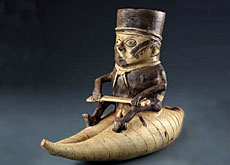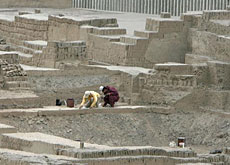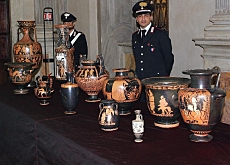Red alert goes out for stolen treasures

Swiss and Peruvian experts have presented a "red list" of Peru's cultural heritage that is particularly at risk from looting and illegal art traffickers.
They hope to draw people’s attention to the “irreparable loss” for the country and for the rest of the world of the disappearance of artefacts that make up part of the South American country’s rich cultural heritage.
On Friday the Federal Culture Office and the International Council of Museums launched the first “red list” of endangered Peruvian cultural property in Basel.
“It’s essential information and an awareness tool that helps the authorities, members of the art dealer community, collectors and museums of the risks in dealing with certain categories of art objects,” said Yves Fischer, responsible for the transfer of cultural objects at the Culture Office.
Peru has a rich history and cultural heritage dating back thousands of years. But over time, artefacts have disappeared into the hands of traffickers and collectors, despite national legislation, international conventions and bilateral accords combating trafficking in stolen antiquities.
While Peruvian archaeological sites have long been the preferred locations for looters, other historical, cultural and religious sites have also attracted unwelcome interest from traffickers.
“The situation in Peru is quite bad. Every day customs officers are coming across illegal objects that are being exported,” Fischer told swissinfo.
Swiss hub
Switzerland is among the world’s five biggest trade hubs for art objects. It was known as a transit point for stolen artefacts before it introduced legislation in 2005 that brought it into line with a United Nations convention against trafficking in illicit goods.
Last December, Switzerland signed a cultural goods deal with Peru aimed at returning stolen goods, particularly archaeological artefacts.
Fischer said that Switzerland’s involvement in the “red list” was its way of showing cooperation with the South American nation on the basis of this bilateral agreement and of fulfilling its obligations.
“We have new legislation and we think the international community should know that Switzerland is taking this [issue] seriously, as well as acting to better protect mankind’s heritage,” he explained.
The cultural goods deal is part of a series of measures by Switzerland to combat trafficking in stolen antiquities. In October 2006 Switzerland and Italy agreed a similar deal against the traffic of illicit goods.
Fischer added that Switzerland had made great strides to improve it bad reputation as a traffickers’ transit point.
“Switzerland made a clear statement that these kind of activities are no longer accepted here. The new measures have a preventive and repressive impact,” he pointed out.
Jean-Frédéric Jauslin, head of the Federal Cultural Office, handed over to the Peruvian ambassador in Switzerland an antique that had been illegally imported and intercepted by Swiss customs officers.
The piece in question was a Chancay ceramic bowl dating from around 1200 AD originating from Peru’s central coastal region.
swissinfo, Simon Bradley
The International Council of Museums (ICOM) is the international organisation of museums and museum professionals which is committed to the conservation, continuation and communication of the world’s natural and cultural heritage.
The ICOM has a network of over 24,000 members in 150 countries. With 1,300 members, ICOM Switzerland is one of the biggest national committees.
The Peru “Red list” is the fifth in a series of publications aimed at combating trafficking in stolen artwork. Previous lists focus on artefacts from Africa, Latin America, Iraq and Afghanistan.
Peru has a history and cultural heritage dating back thousands of years. According to recent archaeological findings, settlements existed as early as 11,000 BC. Around the 13th century BC, cultures such as the Chavín, Chimú, Nazca, and Tiahuanaco migrated into the region, now known as Peru, from the north.
Peru was the centre of Inca rule between 1200 and the 16th century, spanning the area of Latin America which is now home to Colombia, Ecuador, Bolivia, Argentina and Chile.
Spain invaded the Inca empire in 1534, conquering it and destroying the culture.

In compliance with the JTI standards
More: SWI swissinfo.ch certified by the Journalism Trust Initiative




You can find an overview of ongoing debates with our journalists here. Please join us!
If you want to start a conversation about a topic raised in this article or want to report factual errors, email us at english@swissinfo.ch.